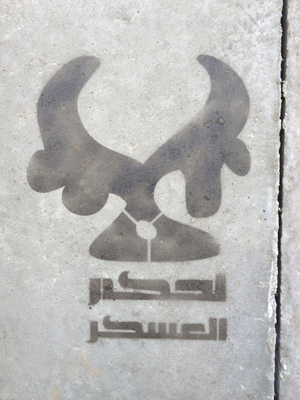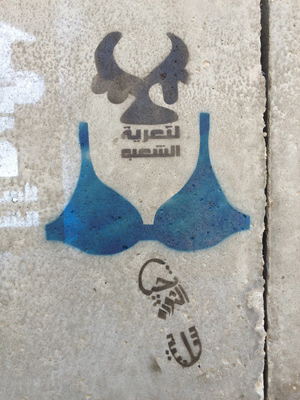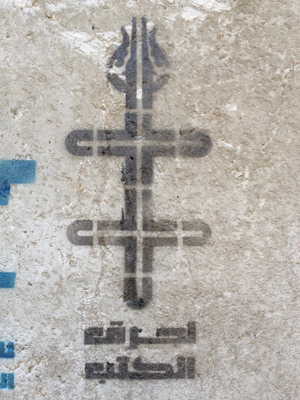Cairo as Canvas
The streets of Cairo have become an open gallery to many artists wishing to express their views, dreams and hopes for a better Egypt. Artists are using the walls of the city to tell their stories, to lament the death of martyrs and to call for political and social change. Thus each painted wall acquires a life of its own, it no longer belongs to a building, a bridge or a street, but it has been recruited to serve a cause and to rally a group of people to support that cause. Artists have discovered that to reach people they have to be physically with them, they have to invade the social spaces of the city and bombard the onlookers with their messages. I have been one of these artists for the past year and a half.
My story started where most interesting stories start, it started with a book. It was not a book I read but a book I wrote. “A Thousand Times No: The Visual History of Lam-Alif” was published in 2010.
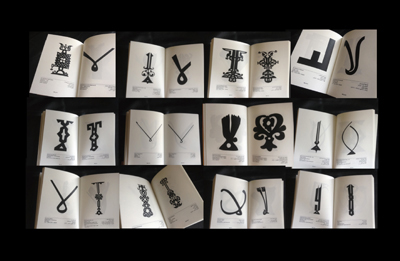
extract from book: A Thousand Times No: The Visual History of Lam-Alif
The book traced the evolution of the word “No” in Arabic on everything ever produced under Islamic or Arab patronage in the past 1400 years from Spain to the borders of China. The book was accompanied by an installation exhibited at the Haus Der Kunst in Munich- Germany in September of 2010.
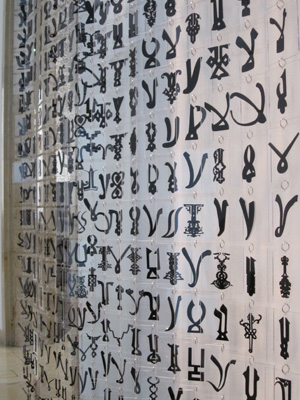
installation view: A Thousand Times No
In November of 2011 I decided to start painting my messages on the streets of Cairo. I felt that I was holding in my hands the history of a word that was most needed on the streets today. Having access to the history of No made me feel like I was sitting on an arsenal of messages. So I started painting messages on the streets:
No to Military Rule, No to Emergency Law, No to Postponing Trials, No to Military Trials, No to a Constitution before the President, No to Stripping the People, No to Blinding Heroes, No to Sniper Pashas, No to Sectarian Divisions, No to External Agendas, No to Killing Men of Religion, No to Infantilizing the People,

wall at Ministry of Interior, Cairo: No to ....
No to Burning books, No to Violence, No to Barrier Walls, No to Third Parties, No to Conspiracy Theories, No to Bullets, No to Tear Gas, No to Aliens, No to the Infiltrating Minority, No to Stealing the Revolution, No to a New Pharaoh, No to Mursi.
Unfortunately I came to discover that a thousand times no are not enough and that I needed to elaborate on my message.
A bus accident that killed 51 children in Assiut-Egypt on November 17th, 2012, left the nation devastated. There was a huge public out cry at first but eventually these children were forgotten.
On January 25th, 2013 I started painting the 51 children of Assiut on the streets of Cairo. I painted each child with their names on their back bags so their names are not forgotten. I painted the brothers and the sisters who have died together on the walls again together. Each child is walking down a train rail with the word Assiut written at the end of the road. The children are painted in black but their dreams are painted in color.
I have painted the children of Assiut on many walls in Cairo but my favorite wall is situated in front of the ministry of interior in down town Cairo. It is a barrier wall, an illegal wall set up by the government to protect itself against protesters.
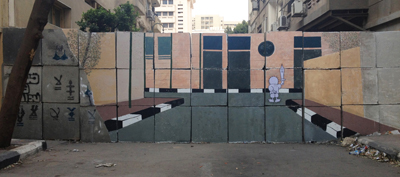
wall at Ministry of Interior, with Handala
This same wall was the first wall I ever covered with my No series on February 15th, 2012. A group of artists came on March 15th, 2012 and continued the street perspective and added a very special character Handala to the wall. This was part of a campaign called “There are no Walls”. The artists painted the street and pretended that there was no wall, they danced and sang and posted photos and celebrated as if there were no walls.
Even though artists danced and sang and pretended that there was no wall, when I came back on January 25th, 2013, the walls were still there.
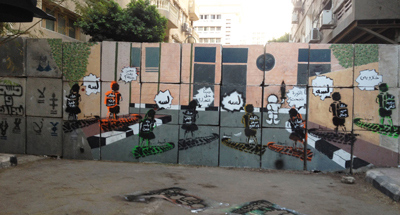
wall at Ministry of Interior: Hide and Seek
So I decided to add 8 children from Assiut to that wall. The children are playing a game of hide and seek, and this is what they are saying to each other:
Mohammad Said Fathy (boy): Khalawees (Are you done? Did you hide?)
Alaa Said Gamal (boy): Not yet
Iman Yehia Ali (girl): Has the revolution succeeded?
Khalifa Saad Ibrahim (boy): Not yet
Sanaa Fathy Ahmad (girl): Did we get the rights of the martyrs?
Menna Yasser Talaat (girl): Not yet
Mustafa Arafa Hussien (boy): Has Egypt become heaven on Earth?
Hana Gameel Arab (girl): Not yet
I hope that this year the children of Assiut will keep appearing on the streets and walls of Cairo to sing and play games and dream of a better future for Egypt but most importantly to remind us of our on-going struggle for the children who are still alive and who deserve a better future. The children of Assiut should remind us of the reasons why we went down to the streets and are still going down till today. “If these walls could talk” is no longer an abstract expression because in Cairo the walls are already in conversation.
text and images: Bahia Shehab, Cairo, Egypt, February 2013
Cairo as Canvas
RELATED WEB SITE
→ TEDTalks 2012
[ Abou Naddara ]
[ Accessible Approach ]
[ Beyrouth ]
• Cairo as Canvas •
[ Dawam al hal min al muhal—No Condition is Permanent ]
[ De Montmorency à Metz ]
[ Dowry No ]
[ Fear of a Muslim Planet ]
[ Fragmented Letters ]
[ Gentle Wall project ]
[ Images and Images ]
[ Kafranbel ]
[ Leading a Smart Revolution ]
[ Lens of a young Person ]
[ Muraqabet amel jidariya—Watching the Creation of a Wall Painting ]
[ No Holy Cows ]
[ On Graphic Crimes and Visible Fractures ]
[ on going ]
[ PMS = Poster Message Service ]
[ Réconciliation ]
[ Rasael—Messages ]
[ Seipone ]
[ T.W.B.T.C ]
[ This is a picture book ]
[ Vitry ]
[ What remains and Things to come ]
FEATURED THEME ON CITY SHARING
by ASUNCION MOLINOS GORDO
-
This project is an instrument for common critical analysis to help understand the reasons behind Egyptians’ diminishing …
by INAS HALABI
-
The project Letters to Fritz and Paul focuses on the expeditions of the Swiss cousins, lovers and scientists, Fritz and …
by SARAH BURGER
-
The planned modern city of Brasilia attracted me since a long time. Her defined shape, location and function proceded he …
by ADRIEN GUILLET
-
Youri Telliug talks with the artist Adrien Guillet about his project Citracit
Youri Telliug - What is Citracit …
by NIGIST GOYTOM
-
In 2013 more than 45 million people have been forced to leave their homes. This amounts to the biggest number of refugees …
by SULAFA HIJAZI
-
The on going debate on Arab identity and its (cultural) representation is strongly shaped by Edward Saidʼs formative …
by ASUNCION MOLINOS GORDO
-
WAM is a site-specific work that uses the historical trope of the cabinet of curiosities to explore the introduction of …
MORE CONTRIBUTIONS BY THE FOLLOWING
